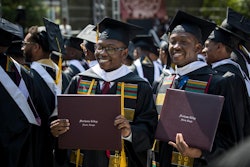College Becoming Less Accessible For Underserved Groups, Studies Find Two influential Washington education advocacy groups are reporting that while much progress has been made in minority access to college in the last 20 years, higher education will become less accessible in the current decade.
The American Council on Education (ACE) in its annual “Status Report on Minorities in Higher Education” released last month found that more than twice as many minorities are enrolled in colleges and universities than 20 years ago, but a gap has opened in enrollment levels between minorities and non-minorities during that time.
In addition, a study released by the Education Committee of the States (ECS) suggests that a smaller proportion of the population will have access to a college education in this decade, and that states will be less able to protect college access because of demographic and economic factors.On the Road to Parity
According to ACE’s 20th anniversary report, from 1980-1981 to 2000-2001 minority enrollment in postsecondary institutions grew from 2 million to 4.3 million. However, while the college participation rate for all races in 1978-1980 was about 30 percent, in 1998-2000, the rate of participation of 18- to 24-year-old White high-school graduates was 46 percent, compared to 40 percent of African Americans and 34 percent of Hispanics.
“Our colleges and universities have experienced substantial gains in minority enrollment over the last 20 years, but there is still much more to be done,” says Dr. David Ward, president of ACE. “We must redouble our efforts to improve the rates at which students of color enroll in postsecondary institutions if minorities underrepresented in higher education are to achieve parity with their White counterparts.”
Over the past 20 years, the high-school completion rate for African Americans increased from 68 percent to 76 percent, while the rate for Hispanics rose from 55 percent to 59 percent. However, the rate for Hispanic men rose by only 1 percentage point while the rate for Hispanic women grew from 57 percent to 65 percent.
Since 1978-1980, the college participation rate increased by 14 percent for Whites, 11 percent for African Americans and 5 percent for Hispanics. The participation rate for 18- to 24-year-old African Americans grew over the 20-year period from 28.4 percent to 42 percent for women and from 30 percent to 37 percent for men. For the same age group of Hispanics, the participation rate for women grew from 27 percent to 37 percent, while for men the rate fell slightly from 31.5 percent to 31 percent.
Total college enrollment grew by more than 3 million students, almost a 27 percent increase. College enrollment for Hispanics and Asian Americans more than tripled from 1980-1981 to 2000-2001, while African American college enrollment grew by 56 percent, and among American Indians the rate grew by 80 percent. According to the study, by 2000-2001, women accounted for 59 percent of the total minority college population.
Minorities went from receiving 11 percent of all bachelor’s degrees in 1980-1981 to earning 22 percent in 2000-2001, and from 11 percent to 19 percent of master’s degrees. Historically Black colleges and universities awarded more than 20 percent of all bachelor’s degrees earned by African Americans in 2000-2001, conferring 25,090 bachelor’s degrees during that academic year.
The report, which summarizes high-school completion rates, college participation and educational attainment, college enrollment, degrees conferred and employment trends, is based on data from the U.S. Department of Education’s National Center for Education Statistics, U.S. Census Bureau and the U.S. Equal Employment Opportunity Commission. It was sponsored by a grant from the GE Foundation, which funds studies of trends related to minorities in higher education.
To order a copy of the report, visit ACE’s Web site at <www.acenet.edu>.College Access Narrowing
The “Closing the College Participation Gap” study, which is part of a multiyear initiative of the Education Committee of the States’ Center for Community College Policy, reported that the United States is falling behind other industrialized countries in college participation and other measures of postsecondary access and attainment. The study also found that existing gaps in college participation and attainment based on age, race/ethnicity and income suggest a growing number of people may be at risk of losing access to a college education, and that demographic and economic forces are converging to limit states’ ability to protect — much less expand — college access over the next decade.
The study, which assists state policy-makers and other leaders in expanding opportunities for postsecondary access and participation, particularly among underserved and disadvantaged populations, profiles each state’s level of postsecondary participation and highlights demographic and economic conditions likely to influence access to participation in the current decade.
“We focus specifically on participation rates as a key indicator of the extent to which states or the nation are preparing their populations with the high level of skills and knowledge that labor markets value and that citizens desire,” according to the study.
The study’s authors say that while demand for postsecondary education will increase substantially during the decade, even if steady revenue growth resumes, most states won’t be able to continue current funding levels based on existing tax structures.
“The challenge that the nation faces is to accommodate not only a greater number of students but also to increase the proportion of the population that goes to college and successfully reaches its learning goals,” the ECS report says.
The report’s authors argue that state policy-makers will need to take the lead in meeting this goal because of their primary role in setting policy and funding public postsecondary education in their states.
“Clearly, state leaders are overloaded with urgent priorities now, yet it remains vital to protect current postsecondary access and prepare to serve a larger and more diverse population of students in the coming years,” argues the report’s authors.
ECS found that higher participation rates of 18- to 24-year-olds in a particular state in 2000 were correlated with the following indicators:
• Percentage of ninth-graders four years earlier who performed at or above proficient on national assessments of either math, science, reading or writing;
• Level of college-degree attainment among the adult population;
• College-going rate of 1999-2000 high-school graduates;
• Percentage of fall 2000 college freshmen in-migration; and
•Amount of state grant aid that goes to low-income students.
“In other words, academic achievement, aspirations, access and affordability are among the factors that help explain a state’s participation rate for traditional college-age students,” the study says.
The study, funded through a grant from the W.K. Kellogg Foundation, was based on data from the 2000 census that was released in 2002, as well as published data from the Organisation for Economic Co-operation and Development and the U.S. Department of Education.
© Copyright 2005 by DiverseEducation.com


















